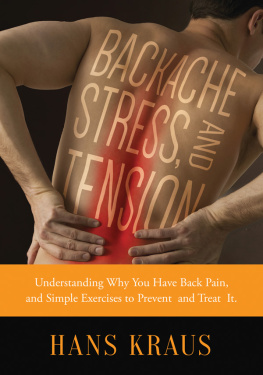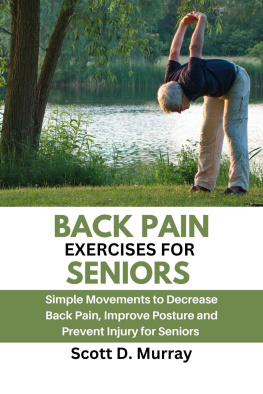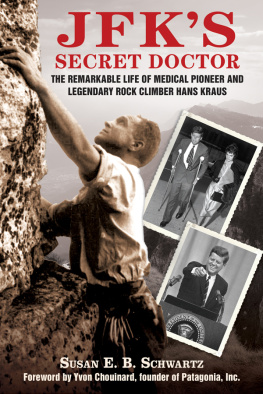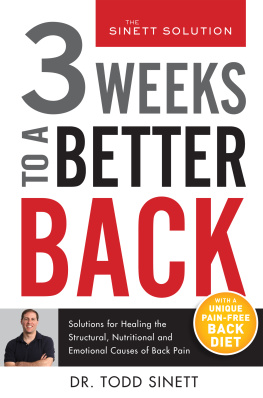
Copyright 1965, 1993, 2012 by Frances L. Kraus
Foreword 2015 by Skyhorse Publishing
Foreword to the 2012 edition copyright 2012 by Robert H. Boyle
Photo and design copyright 2012 by Skyhorse Publishing, Inc.
For permission to use the following materials, the author wishes to thank:
Charles C. Thomasfor material and illustrations from my books, Principles and Practice of Therapeutic Exercises , copyright 1949, 1963, and Hypokinetic Disease , copyright 1961.
The Lancet for statistics from Coronary Heart-disease and Physical Activity of Work, by Morris, J. N., Heady, J. A., Raffle, P. A., Roberts, C. G., and Parks, J. W., in Lancet 2:1053, November 21, 1953, and 2:1111, November 28, 1953.
Dr. Lloyd Appletonfor the graph on Discharge of West Point Cadets with Psychiatric Endorsement.
New York State Journal of Medicine for use of the diagram in my article Preventive Aspects of Physical Fitness, in Vol. 64, No. 10, May 15, 1964.
Sports Illustrated for the quotation from the article The Soft American by John F. Kennedy, December 26, 1960.
Dr. Jean Mayerfor the table from his Nutrition in Clinical Medicine , copyright 1960.
Dr. Jean Mayer and Harper & Rowfor the conclusion from the chapter Exercise and Weight Control in Science and Medicine of Exercise and Sports .
ALL NAMES OF PATIENTS MENTIONED IN THIS BOOK ARE FICTITIOUS.
All Rights Reserved. No part of this book may be reproduced in any manner without the express written consent of the publisher, except in the case of brief excerpts in critical reviews or articles. All inquiries should be addressed to Skyhorse Publishing, 307 West 36th Street, 11th Floor, New York, NY 10018.
Skyhorse Publishing books may be purchased in bulk at special discounts for sales promotion, corporate gifts, fund-raising, or educational purposes. Special editions can also be created to specifications. For details, contact the Special Sales Department, Skyhorse Publishing, 307 West 36th Street, 11th Floor, New York, NY 10018 or .
Skyhorse and Skyhorse Publishing are registered trademarks of Skyhorse Publishing, Inc., a Delaware corporation.
www.skyhorsepublishing.com
10 9 8 7 6 5 4 3 2 1
Library of Congress Cataloging-in-Publication Data is available on file.
Print ISBN: 978-1-63220-457-8
Ebook ISBN: 978-1-63220-773-9
Cover design by Rain Saukas
Printed in China
Contents
Publishers Note:
Before following any advice, practice, test, or exercise suggested in this book, it is recommended that you consult your doctor as to its suitability, especially if you suffer from any health problems or special conditions. The publishers, the author, and the photographer, cannot accept responsibility for any injuries or damage incurred as a result of following the exercises in this book, or of using the therapeutic methods described or mentioned here.
Foreword
HANS INVITED ME TO JOIN HIM FOR LUNCH AT THE NEW York Athletic Club where he was a lifetime member. The conversation led me to tell him that my medical practice involved teaching patients how to manage their persistent pain. He said, given the choice, would a patient prefer to get rid of the pain or manage it? Why dont you get rid of it? I explained that when the pain has been there for months or years, it may not go away. He answered, how do you know its not coming from muscles? I said, I had examined my patients, but he persisted. I was amazed to hear he had an 80% success rate in treating 300,000 patients with back pain at the YMCA.
Hans Kraus, M.D. changed my life, and the lives of thousands of my patients, and perhaps your life as well. He taught me when no one else did: that muscles were the source of most back pain. His studies with his colleagues at Columbia University School of Medicine demonstrated that restoring strength and flexibility in the muscles that keep us upright, could reduce or eliminate back pain. Hans understood the complexities of back pain and the importance of evaluating and treating muscles whenever there was persistent pain. His approach relieved President JFK of back pain after his prior back physician, Janet Travell, had failed to help the President with repeated trigger point injections. Hans recognized that emotional tension and deconditioning (weakness and/or stiffness) were common causes of back pain that were rarely, if ever, addressed. With the aide of his like-minded colleagues, Dr. Walker in Psychiatry and Eugene Cohen, and Larry Sonkin in Endocrinology, along with his excellent physical therapy staff, he was able to eliminate back pain in patients who would have had unnecessary surgeries.
Hans understood that MRIs and CT scans could demonstrate abnormalities that were not related to the patients pain. He told me to use imaging studies to confirm a diagnosis I suspected as opposed to finding a diagnosis. Since most MRIs of the lower spine in adults are read as having some abnormality, he taught me to be careful when discussing with patients the results of their studiesquoting one of his mentors, Dr. Eugene Bauer at the University of Vienna School of Medicinewho said A word in the mouth of a physician is as dangerous as a scalpel in the hands of a surgeon.
Despite his success in treating many luminaries in organized medicine who came to him with complaints of low back pain, he was not able to get their support; Jonas Salk whose back pain was alleviated told Hans what you do is not scientific and therefore Salk would not endorse a research study that Hans had proposed.
This resistance continues today. Despite the recognition that muscles, tendons, and ligaments are the source of approximately 70 percent of cases of low back pain, the guidelines for the evaluation and treatment of low back pain from the American College of Physicians and the American Pain Society do not recognize the importance of muscles. We continue to spend more money each year on back (and neck) pain100 billion in 2005, and cant understand why there are increasing numbers of patients who are disabled with their pain. The fight against low back pain cannot be won unless we acknowledge its major cause.
Hans spent five years with me at Lenox Hill Hospital, teaching me and my colleagues how to evaluate and treat back pain so that muscle pain, the most common cause of back pain, would always be considered and treated first. I will always be grateful for his revolutionary understanding of common pain problems, which is chronicled in his book, Backache, Stress, and Tension , and remains an important resource for patients and physicians.
Norman Marcus, MD
Director, Norman Marcus Pain Institute
Associate Professor of Anesthesiology and Psychiatry
Director, Division of Muscle Pain Research
NYU School of Medicine
Foreword
to the 2012 Edition
IF YOU SUFFER FROM LOW BACK PAIN, THIS BOOK CAN BE your life saver. I know because I had back pain so crippling after a car accident that I thought I would spend the rest of my life in a wheelchair. But I became a new man after Dr. Hans Kraus started me on the therapeutic exercise program shown on .
How could that have happened? The answer is simple. Hans and his associates at Columbia-Presbyterian Medical Center in New York City had, as he recounts in this book, found that slightly more than 80 percent of the cases of low back pain suffered by some 3,000 people came from tense and/or weak muscles, not the spine, and that therapeutic exercises could correct the problem.










